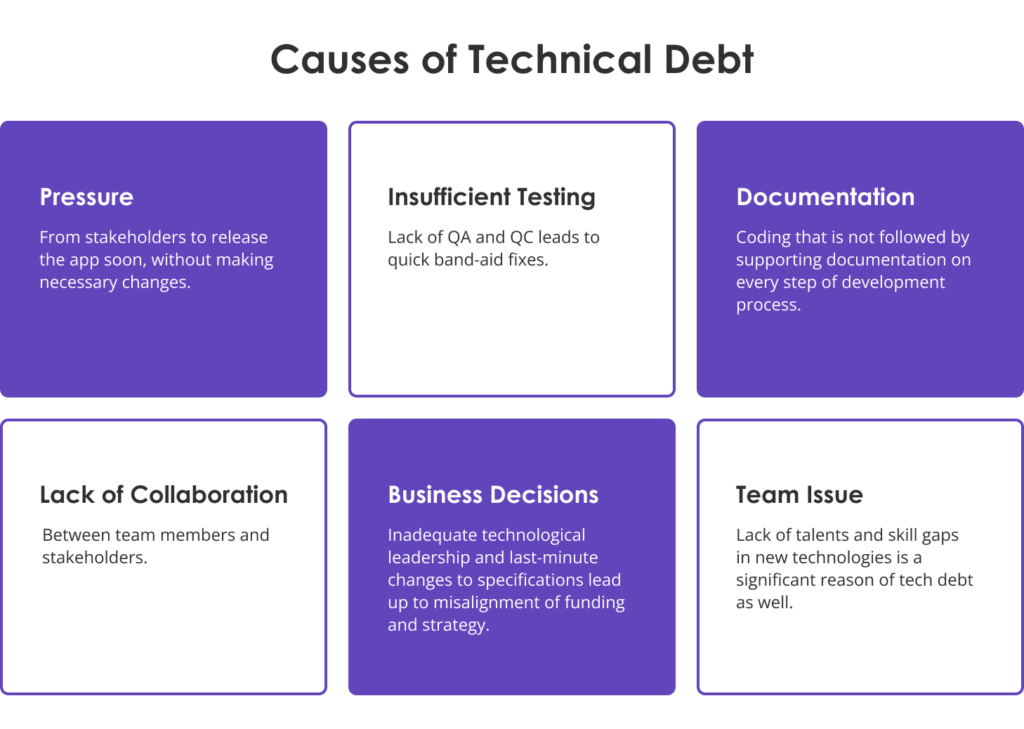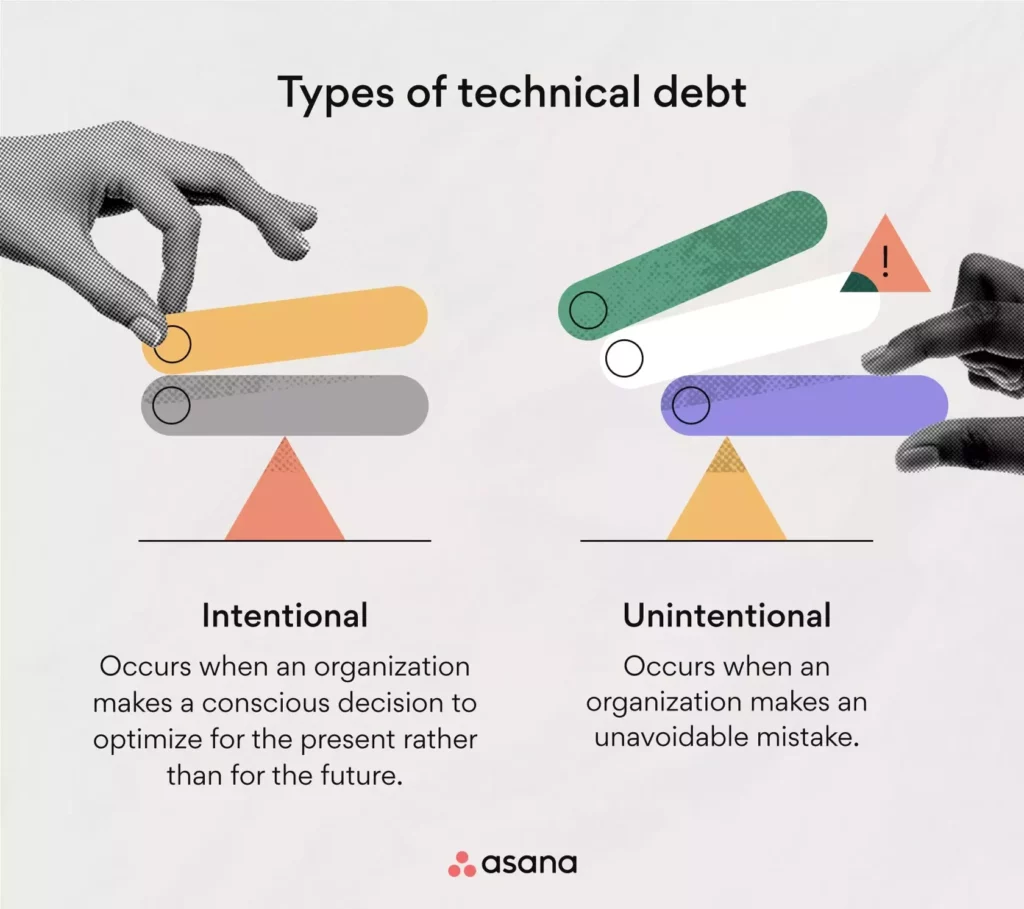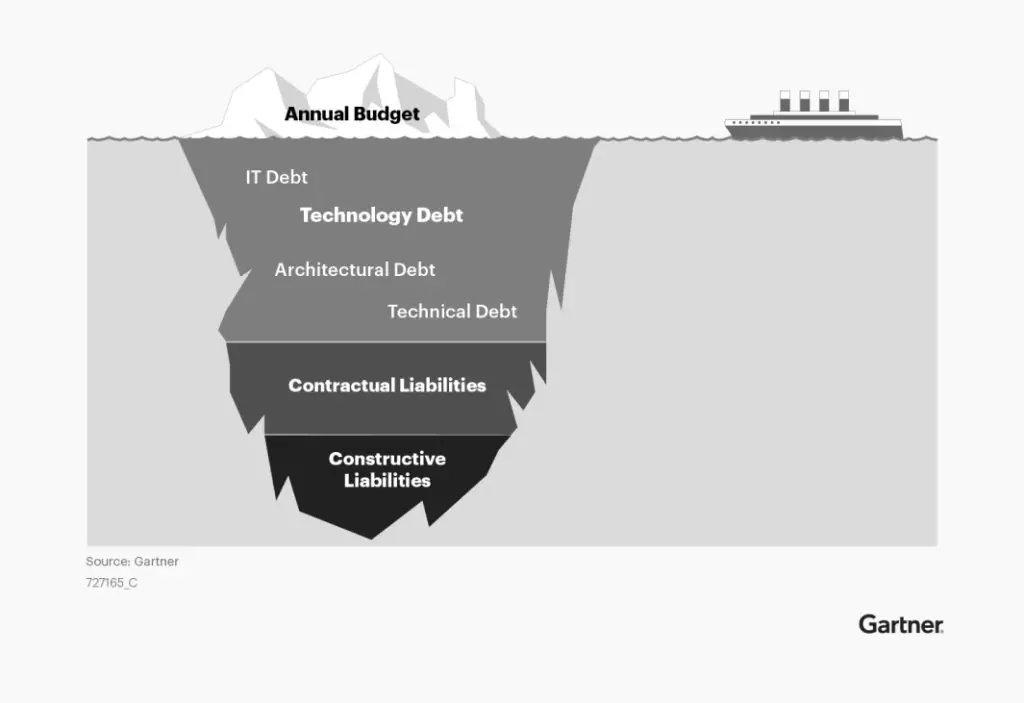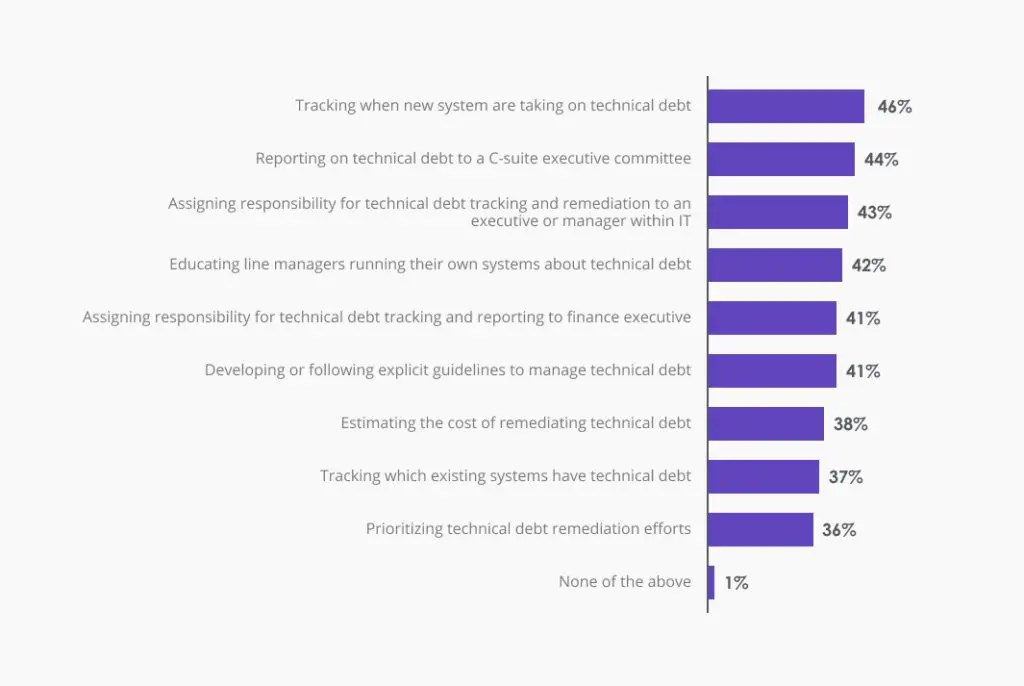
We got used to viewing technologies as the primary vehicle of progress, which is true. However, there’s also the flip side of the coin: early subpar technological choices when left unpruned can grow into dragging down technical debt. Budget losses, long time-to-market, and disruption of productivity are all symptoms of unresolved tech issues.
But how do you turn the tables and make your systems work for you (instead of the other way around? The first step is recognizing what tech debt actually is.
What is Technical Debt?
Technical debt (TD) refers to the practice of relying on temporary easy-to-implement solutions to achieve short-term results at the expense of efficiency in the long run. That’s a metaphor, proposed by Ward Cunningham, author of Agile Manifesto, for describing the impact of accruing tech issues.
As the term suggests, swept-under-the-rug software architecture and code issues lead to accumulating tech debt. Paying it back (i.e., addressing the issues ignored during previous iterations) would be like paying interest on a loan — expensive and constraining at times.
How Do We Accumulate Technical Debt?
Even by existing, a business accumulates some tech debt since new ways of improving the product are constantly emerging. According to a McKinsey report, technical debt accounts for 20% to 40% of survey respondents’ entire technology estates. Most large companies “owe” hundreds of millions of dollars in unpaid tech debt.

Beyond that, common causes of technical debt include:
- Pressure from stakeholders to release the app soon, without making necessary changes
- Insufficient testing (QA and QC), which leads to quick band-aid fixes
- Coding without supporting documentation
- Lack of collaboration between team members and stakeholders
- Inadequate technological leadership
- Last-minute changes to specifications
- Lack of talents and skill gaps
- Misalignment of funding and strategy
The Two Types of Technical Debt
The two types of technical debt are:
- Intentional tech debt (also called deliberate or active) happens when the team consciously delays the resolution of some issues to achieve the set goal (e.g., to release the update faster).
- Unintentional tech debt (also called accidental, outdated, passive) occurs when the team is doing a subpar job without even knowing it while accruing many issues along the way.
The impact of technical debt for your project depends on how you deal with it. Ultimately, borrowing money can be a great way to accomplish something sooner than otherwise would be possible. In the same way, taking coding shortcuts may help you initially win the necessary time and resources to tackle more urgent software development tasks.
Difference Between Intentional and Unintentional Tech Debt:

Intentional Technical Debt: When Is It a Necessary Short-Term Strategy?
Tech debt is not always bad, especially if you have the resources, knowledge, and time to repay it in the future. Intentionally creating tech debt is often about prioritizing business needs over technology decisions.
Intentionally creating tech debt can allow you to:
- Get timely user feedback on new features
- Secure required investments
- Enter a fast-growing market
- Present a minimum viable product (MVP) to stakeholders
Intentional technical debt should be a conscious, thoroughly documented strategy. To ensure efficient technical debt management, rely on the following practices:
- Have a framework for documenting intentional technical debt
- Make sure tech debt doesn’t majorly affect reliability or security of your product
- Identify the impact of the tech debt on the upcoming sprints
- Keep the team in the loop about technical debt accumulation
- Set up plans for technical debt reduction in the future
However, when you accrue tech debt due to external pressures (deadlines, stakeholder demands), don’t pay it back, or fail to acknowledge its existence, it becomes a significant impediment. Referring to the technical debt over and over may get your project off the rails.
Why Unaddressed Technical Debt is a Hot Button Issue for Businesses
It is dangerous for the success of a project if the debt is not repaid while it keeps increasing. When you have unresolved technical debt, funds, time, and efforts go to waste instead of benefiting the product. Furthermore, when technical debt accumulates, it can hinder the resilience of IT systems by making them more vulnerable to disruptions.

Some of the common consequences of unaddressed tech debt are:
- Reduced flexibility: Tech debt makes it difficult to scale and adopt new technologies. The Accenture Federal Digital Decoupling Study indicates that 81% of companies feel they cannot move to new technologies because of technical debt.
- Discontinuity: TD causes disruptions to core business operations, mission, and operational programs in 81% of organizations as per the same report.
- Development time inefficiency: Every week, Software Developers spend 13.5 hours fixing tech debt issues. This time can definitely be put to better use.
- Issues with testing: As problems pile up, it is more challenging to keep track of them, let alone fix them. Testing becomes more complicated when the team refers to manual testing as the main way to handle TD.
- “Hitting the wall”: A mountain of tech debt slows progress and improvement of the application. A study by Accenture found that 82% of respondents believe that technical debt in their legacy systems greatly limits their ability to augment or enhance the systems in question.
- Budget losses: McKinsey has estimated that 10% to 20% of a company’s technology budget is diverted to repaying tech debt.

- Bruised team productivity: Growing problems require people to put in extra effort when handling them, which wears down their energy. Paying down technical debt is detrimental to team morale in 76% of cases.
- Loss of competitiveness: Problems constantly arise, causing new plans for development to stall. Meanwhile, Developers focus on fixing the “good old” bugs. Because there is a need to spend your resources addressing tech debt, you are nowhere near creating something new. As a result, you cannot move as fast as your competitors and quickly respond to dynamic market needs.
If you recognize any of the above symptoms in your project, you should at least estimate how much tech debt you already have. Once that is done, you should seek remedies — implement debt management practices.
How to Manage Technical Debt: 6 Reduction Strategies
As soon as you become aware of your tech debt, make sure you consistently take other steps to reduce it. By McKinsey estimates, companies who are proactive with tech debt management manage to reduce their TD from 75% to 25%. So you too should get to action! Here are the most common techniques for managing technical debt.

Source: Accenture Federal Digital Decoupling Study
1. Create a Shared Definition of Tech Debt in Your Company
Various perspectives, from both tech and business, are necessary for a project to succeed. However, these contrasting viewpoints cause Software Developers and Project Managers to have different ideas of what technical debt is.
Business teams may understand TDs primarily as the negative effects of technological failures on business manifested in higher operational costs and a slower time to market. In a tech context, TD reduces the quality of code, testing, and design. In reality, everyone is correct, but all parties should view the issue from a common perspective, understanding both the business and technical implications of debt.
2. Strictly Define a Timeframe and Activities to Mitigate Tech Debt
Even if you realize the problem at once, it is not the end of the solution process. For instance, Carnegie Mellon University states that even though their respondents were aware of their technical debt, there were no procedures in place to handle it in 65% of cases. So, take action, as paying off technical debt requires consistency in terms of time, money, and effort.
As there are no one-size-fits-all metrics created to track or measure technical debt, you can try making a list of tasks and schedule hours devoted solely to addressing tech debt. Also, it helps to formalize the decision-making process as to how and when to handle TD activities. Such practice encourages IT departments and business leaders to collaborate and resolve conflicts of interest.
In their fight against TD, some companies go beyond simple planning and create special departments made up of Architects whose job is to resolve the technical debt.
3. Introduce Code Standards and Reviews
Code standards are collections of programming rules, guidelines, and best practices. They help Developers write clean, readable code and easily address any changes that may need to be made later. Coding standards reduce the tech debt in the long run by clarifying and unifying the standards of a “good app”.
Code review is a process where Developers audit each others’ codes for errors. In addition to avoiding potential issues, this practice allows the team to learn from one another and develop their skills.
4. Embrace Agile Software Development Practices
Mitigating technical debt is more effective when you pay it off regularly every single sprint. And agile software development methodologies help the team to consistently deliver a level of quality during small increments of work.
Agile ensures that all TD tasks are included in the Product Backlog, which makes tracking easier. Also, Agile allows you to choose the definition of “done” based on your understanding of product quality, keeping technical debt under control.
5. Refer to Automated Testing Activities
Automated testing involves using software tools to detect bugs and errors in the system, double-check the code, and validate the quality of the software. Software Developers, as well as dedicated QA Engineers, are typically responsible for conducting automated testing alongside their regular development activities.
The use of automation transforms quality control because it eliminates the need for manual testing, which speeds up issue detection and reduces the chance of human error. Also, automated tests allow QA teams to work on more sensitive issues that require human expertise. Automated testing accelerates the bug detection process and reduces human intervention, negating technical debt.
6. Start Refactoring Problematic Code
Refactoring is a process of restructuring the messy code in order to make it more understandable, maintainable, and bugless. This practice is a necessary part of modernization and tech debt payoff, as it helps transform the legacy code. The regular execution of minor refactorings is one of the few ways to reduce technical debt to a possible minimum. Refactoring produces cleaner code, making future refactoring activities easier to perform. You can therefore consider this an investment in your future battles against TD.
Conclusion
It’s inevitable that some suboptimal tech decisions will be made early on, contributing to technical debt. To avoid letting tech debt grow into an unmanageable backlog, get proactive in managing it.
Preventive measures are better than curative measures. So, the sooner you start reducing the detrimental impact of tech debt on your project, the sooner you will be able to keep up with your competitors. The market needs are so dynamic — we shouldn’t let some pile of old defects keep us from catching up with them.
Interested in starting a new software development project or seeking help with modernizing and refactoring a legacy application? Contact Edvantis specialists for a consultation.






